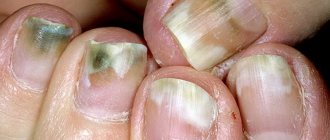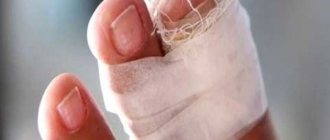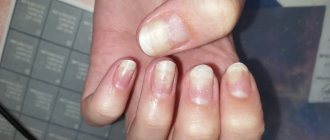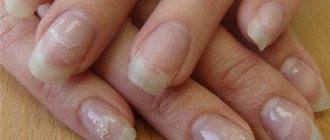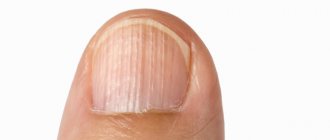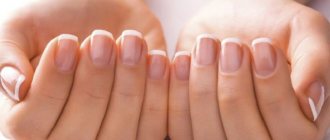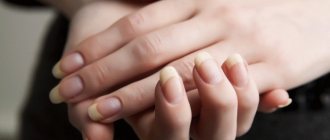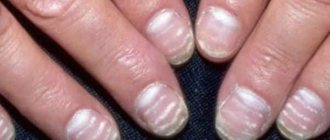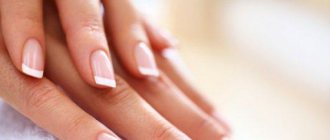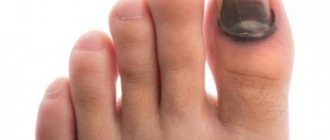Onychodystrophy (nail dystrophy) - symptoms and treatment
At the moment, there is no unified classification of onychodystrophies. Based on their origin, they can be divided into two groups:
- congenital onychodystrophy;
- acquired onychodystrophies.
Congenital onychodystrophies develop as a result of gene mutations and are inherited. The last group of diseases are in turn divided into:
- isolated onychodystrophy ;
- onychodystrophy, as part of other diseases.
Let's take a closer look at each group of diseases.
Isolated onychodystrophy
This subgroup of diseases includes: brittle nails, onychoschisis, Bo's furrows, onycholysis, onychogryphosis, leukonychia, the formation of longitudinal grooves and hyperpigmentation. Most often they develop as a result of ultraviolet irradiation, mechanical and chemical damage.
Brittle nails are the most common deformation of the nail plate. It is accompanied by breaking off the free edge of the nail with the destruction of all its layers. Occurs predominantly in women. The reasons for brittleness are frequent contact with hot water and abuse of manicure.
Onychoschisis is a transverse separation of the nail plate without signs of inflammation. With this disease, the nail grows correctly to the free edge, after which the nail plate splits into 2-3 layers. The most commonly affected nails are the index, middle and ring fingers. The reasons are repeated minor mechanical injuries, including improperly performed manicure, playing stringed musical instruments, etc.
Bo's groove (manicure onychodystrophy) is another common type of dystrophy. Characterized by the appearance of a transverse groove on the nail plate. It often forms on the nails of the thumb, index and middle fingers. The reason is a violation of the technique of removing gel polish using cutters.
Onycholysis is a common pathology in which the connection between the nail plate and the nail bed is broken. The separated part of the nail may take on a white-gray tint. The surface of the nail, as a rule, remains smooth, but if a fungal or bacterial infection is attached, the nail plate becomes uneven, rough and bumpy, thickened or brittle.
There are quite a few causes of onycholysis. These include:
- injury or compression of the nail;
- taking antibiotics such as tetracycline and fluoroquinolones;
- use of low-quality varnishes;
- avitaminosis;
- chronic dermatoses, diseases of the nervous, endocrine, digestive and cardiovascular systems;
- neurotic disorders (onychotillomania - the obsessive habit of destroying one's own nails using various devices, and onychophagia - the habit of biting nails and hangnails).
Onychogryphosis is a sharp thickening (hypertrophy) of the nail plate with the acquisition of a convex shape. As it grows, the affected nail begins to curl like a spiral or horn. The color of the nail plate becomes dirty yellow or brown.
The exact cause of onychogryphosis has not been established. The participation of external and internal factors is assumed. External triggers include various injuries to the nail apparatus, frostbite, wearing tight shoes, local infections and anhidrosis (impaired sweating). Internal triggers include diseases of the immune system (HIV), age-related endocrine disorders, chronic skin diseases, syphilis and varicose veins of the lower extremities.
Leukonychia is the most common form of nail pigmentation, in which white areas of various shapes and sizes are observed in the thickness of the nail plate.
There are three forms of this disease:
- dotted (spotted) or stripe-like (changed areas disappear as the nail grows);
- subtotal (partial damage to the plate);
- total (persistent damage to the entire nail).
Causes of the disease: use of low-quality nail polish, illiterate manicure and pedicure, frequent contact with household chemicals, wearing tight shoes, lack of microelements (iron, calcium, zinc) and vitamins A, E, C, D.
Longitudinal grooves are superficial, weakly expressed single or multiple lines on the nails. It is observed both in healthy people and in cases of matrix dysfunction. The reasons are a lack of zinc (mainly in vegetarians), careless manicure and abuse, cuticle or matrix injuries, decreased immunity and frequent stress.
Nail hyperpigmentation occurs when pigments such as hemosiderin and melanin accumulate. As a result, the nails acquire a yellow or brown tint. Depending on the cause, there are two types of hyperpigmentation:
- medicinal - after taking tetracycline and resorcinol;
- chemical - after prolonged use of manicure varnishes.
Onychodystrophy, as part of other diseases
Onychorrhexis is a longitudinal separation of the nail. This pathology is observed in chronic dermatoses, constant contact with chemicals and solutions that dry out the nail plate.
Scleronychia is a special form of nail hypertrophy. It is characterized by the hardness of the nail plate, complete loss of elasticity and transparency. Leads to separation of the nail graft from the bed, similar to onycholysis. The nail becomes yellow-brown and the lunula disappears. The cause of the disease is endocrine disorders.
Trachyonychia is a rather unusual form of dystrophy. The nail plate is characterized by the absence of a lunula and the presence of small thin scales with a dull nail color. This pathology occurs in immunodeficiency.
Thimble-shaped nail wear - pinpoint depressions and pits on the surface of the nail plate, resembling a thimble. Most often, this nail dystrophy occurs with psoriasis, exfoliative dermatitis, alopecia areata and lichen planus.
Onychodystrophy of the “roof slats” type is nail dystrophy in the form of shallow longitudinal ridges or grooves located in parallel. Occurs in lichen planus and senile atherosclerotic microangiopathy - atherosclerotic lesions of small blood vessels in elderly people.
Nail patterns - erasing of the free edge of the nail due to constant scratching of itchy lesions. The edge of the nail plate itself becomes somewhat concave. Such dystrophy occurs in chronic itchy dermatoses - neurodermatitis and eczema.
Hapalonychia is a rare form of onychodystrophy in which softening of the nail plate occurs. Such a nail easily bends and breaks off, and cracks form on the free edge. The cause of this pathology is a violation of sulfur metabolism during the formation of keratin in the nail.
Congenital onychodystrophy
Onychomadesis is the separation of the nail plate from the nail bed from the side of the ridges. The process occurs quite quickly and acutely, sometimes accompanied by pain and inflammation. Once matrix function is restored, a healthy nail plate grows. With relapses, atrophy of the nail bed may develop, which leads to complete loss of the nail. This type of onychodystrophy can be inherited and first appears after a finger injury.
Koilonychia is a saucer- or cup-shaped depression on the surface of the nail. The nail plates of the hands on the index and middle fingers are most often affected, but sometimes all nails are involved in the pathological process. The exact cause of the disease is unknown; the role of a hereditary factor is assumed. Cases of koilonychia occurring against the background of anemia, thyrotoxicosis, Cushing's disease, typhoid fever and other diseases have been recorded.
Anonychia is the congenital absence of one or more nails. This pathology is rare and is a hereditary anomaly. It can simultaneously occur with a violation of the structure of the hair, the functioning of the sweat and sebaceous glands and other developmental defects.
Platonychia is a flattening of the nail plate, the absence of its natural convexity. This type of dystrophy is quite rare and is an anomaly.
Micronychia are short nail plates on the fingers, less often on the toes. Can be inherited. Sometimes it is a sign of other diseases (for example psoriasis).
Hippocrates' nails are a genetic disease of the nail apparatus, characterized by convex nail plates that resemble “drumsticks.” The nails look rough, but they are also quite fragile. The exact cause of this pathology is unknown [1][4][5][7].
Cosmetical tools
Velvet handles, Nail and cuticle cream
The cream effectively moisturizes the cuticle, making it soft and pliable, and also strengthens the nail plate. Contains vitamins A, E, F, as well as jojoba oil and fruit acids. The cream should be applied to nails without decorative coating.
Organic Shop, Nail Strengthening Oil
The product contains 2 types of oils - lemon and tea tree. 100% natural product without the addition of artificial colors and preservatives. The oil is rubbed into the nail plate daily. Nails must be clean and without any type of coating.
Domix Green Professional, Intensive complex nail therapy
Calcium and vitamin E activate collagen synthesis, which prevents delamination and also helps strengthen the nail plate after gel polish or extensions. The composition also includes iodine and algae extract to maintain water balance.
Eveline Nail Therapy Professional, SOS
The emergency remedy shows the first results after 10 days of use. Includes a multi-vitamin complex, as well as calcium and collagen. Apply to clean nails in 1-2 layers. Can be used under cosmetic varnish. Course – 1-2 months.
Zinger, Nail & Cuticle Oil
The oil is intended to soften the nail plate, strengthen its root part, and also to prevent delamination. Rub the oil onto clean or varnished nails and cuticles for 1 minute.
Mavala, nail strengthener
It has a penetrating effect - it is absorbed into the nail and glues all its layers to prevent peeling. Apply only to the tip, while the hand should be in a lowered position until it is absorbed. Absorption time – 1-2 minutes. Allowed for use no more than once a week.
Nail lamination - procedure and review of products
Excessive cleanliness
Aggressive detergents and even ordinary dishwashing gel can seriously damage your hands: make your skin dry and your nails dull, weak and brittle. Also, nails peel when they come into contact with water for a long time.
What to do
Keep your nailsFingernails: Do's and don'ts for healthy nails / Mayo Clinic dry and clean. If you have to wash dishes, wash by hand, or come into contact with chemicals, it is better to use cotton-based rubber gloves.
Proper nutrition
Peculiarities:
- To strengthen nail tissue, amino acids are needed; they make up the strong protein keratin.
Minerals such as calcium, iron, phosphorus, silicon, chromium, selenium, zinc and sulfur are also extremely important. Sulfur atoms, for example, provide bonds between chains of keratin molecules, making nails strong and not prone to brittleness and delamination. - To fully provide the body with nutrients, you need to include a variety of healthy foods in your diet.
- First of all, it is strictly not recommended to consume fried and fatty foods, sausages, and unhealthy sweets.
- Vegetables, fruits and herbs must be included in the menu. It is a storehouse of all kinds of vitamins and minerals.
- To prevent dehydration, adults must drink 1.5–2 liters of water per day, in addition to the rest of the liquid.
- Dairy products - cheese, cottage cheese, milk, yogurt, as well as greens - will help provide the body with calcium.
- It is recommended to eat cereals and wholemeal bread, since cereals contain a huge amount of vitamins B1, B2, B6, which are very beneficial for nails.
- Vegetable oils and nuts are sources of vitamin E, so they should be present in the diet.
- Do not neglect foods rich in omega-3 fatty acids. They are found in flaxseed oil, fatty fish, nuts and mangoes.
- To get iron and zinc into your body, it is important to regularly consume meat and offal.
- Collagen is essential for healthy nails, so you should include jelly, jellied meat and broths in your diet.
Take care of the health and hygiene of your body, and then your nails will delight you with beauty and impeccable appearance.
Types of pits: description and photo
Dents are:
- Transverse . Such depressions on the nails look like parallel grooves with a depth of 0.5 to 2 mm, or in the case of other causes they look like a wide groove.
- Longitudinal . They are expressed by even parallel stripes located vertically. Compared to transverse dents, they are relatively shallow.
- Holes . Such dents can be quite deep and reach almost to the skin.
- Pits . With such defects, the surface of the nail may look like a thimble. The points are scattered randomly, one at a time, or form longitudinal rows of several.
Photos of varieties of pits on nails:
Transverse:
Longitudinal:
Large depressions:
Pits:
How to understand what the reason is?
Only a doctor can determine the exact cause, as this will require a comprehensive examination. But some things are easy to guess for yourself.
If:
- when you press on the nail, it bends, it hurts, probably due to contact with household chemicals;
- the plate breaks due to varnishes or removers, the nails will be rough and porous to the touch due to drying out. They also lose their natural healthy color and acquire a yellowish tint;
- the reason why nails break is due to vitamin deficiency, hair falls out, hair ends split, skin condition worsens;
- If your fingernails and toenails suffer at the same time, this is due to internal diseases.
Home Remedies
As a preventive measure or an additional method of treating peeling nails, it is recommended to use folk recipes for masks, baths and compresses.
Usually used for strengthening:
- salt;
- gelatin;
- clay;
- iodine;
- oils – vegetable or cosmetic;
- red pepper.
Sea salt bath
- Dissolve 1 tbsp in 1 liter of water. l. sea salt;
- Soak your fingertips for 10-15 minutes. Make sure that the water is not too cold or hot - the optimal temperature is 38-40 degrees;
- Wash your hands under running water to remove any remaining salt.
The bath should be repeated 1-2 times a week. Salt has an antiseptic and strengthening effect.
Gelatin bath
- Dissolve 1 tbsp. l. gelatin in 1 glass of warm water, stirring occasionally;
- Place your hands in the resulting solution for 10-15 minutes;
- After the procedure, rinse your hands under warm water and apply nail and cuticle cream, rubbing it in with massage movements.
Hand baths: 30 recipes for different purposes
Red pepper mask
Red pepper, due to its warming properties, improves blood circulation, stimulates the regrowth of the nail plate and prevents nails from peeling.
- Mix 1 tbsp. l. any hand cream, 0.5 tsp. ground red pepper and 1 tsp. water;
- Heat the mixture in a water bath to activate the effect of the pepper;
- Apply the product to your fingertips and leave for 7-10 minutes;
- Remove any excess with a paper towel and wash your hands under warm water.
Make sure that there is no red pepper left on your hands after rinsing, otherwise it may get into your eyes and cause severe discomfort. Do not make a mask more than 1-2 times a month.
Olive oil mask
A mask using olive oil is done before bed to prolong its effect as much as possible.
- 1 tbsp. l. mix olive oil with 5-7 drops of any essential oil - tea tree, shea, jojoba;
- Heat the mixture in a water bath to 38-40 degrees. You can determine the temperature by touch - the composition should be hot enough, but not burn your hands;
- Apply the product to your nails and rub in with massage movements for 10-15 minutes;
- Put on cosmetic cotton gloves directly over the remaining oil and leave overnight.
Repeat the mask 2-3 times a week until the desired result is achieved, or alternate with salt baths.
Hand masks: 30 homemade recipes
Iodine
Iodine can be applied to the nails as a supporting agent, but in this case it is necessary to follow a number of recommendations;
- Do not apply iodine more than once a week. It tends to dry out nails with systematic exposure;
- Use iodine at night. During this time, almost all the yellowness will be absorbed into the nail plate;
- After using iodine masks, apply oils to your nails and cuticles and rub them in with massage movements, this will help compensate for dryness.
Clay mask
- Mix 1 tbsp. l. white cosmetic clay with 0.5 tbsp. l. milk. The consistency of the product should resemble a paste;
- Add 1-2 drops of cinnamon oil and a couple of drops of lemon juice and apply the mixture to your nails. Wear nitrile or medical gloves over the top.
Leave the mask on for 15-20 minutes, then rinse with warm water. Repeat no more than 2 times a month.
Green nails and pseudomonia disease: causes, diagnosis and treatment options
